Mobility Hubs, Safer Sidewalks, Pedestrian Crossings Key Elements of Finalized West Hartford Center Infrastructure Master Plan

Audio By Carbonatix
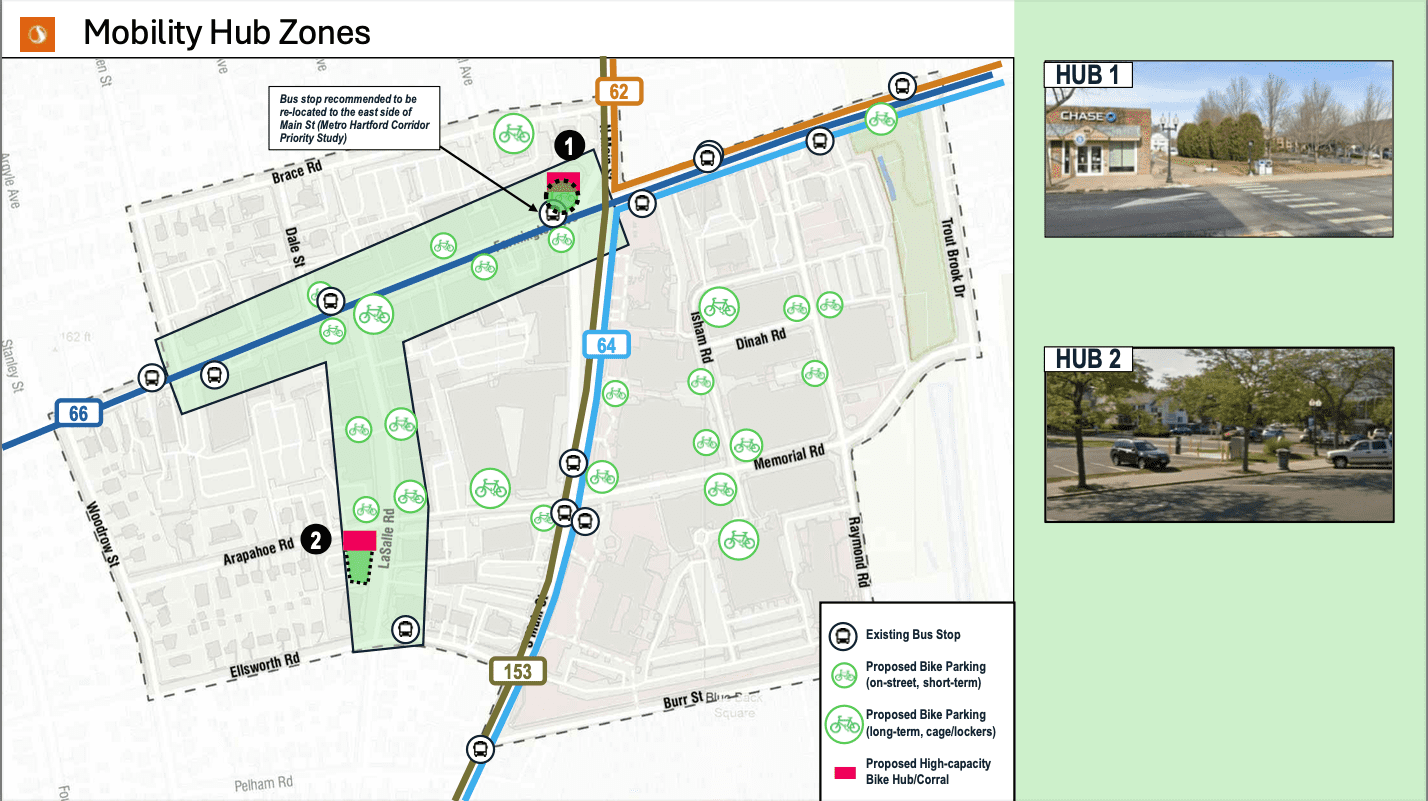
One of the key elements of the West Hartford Center Infrastructure Master Plan will be 'Mobility Hub" zones with areas for renting and charging e-bikes and scooters as well as sure storage for other bikes and pick-up/drop-off rideshare areas. Town of West Hartford image
Town Manager Rick Ledwith unveiled the final infrastructure plan to the Town Council’s Community Planning and Economic Development Committee Tuesday morning.
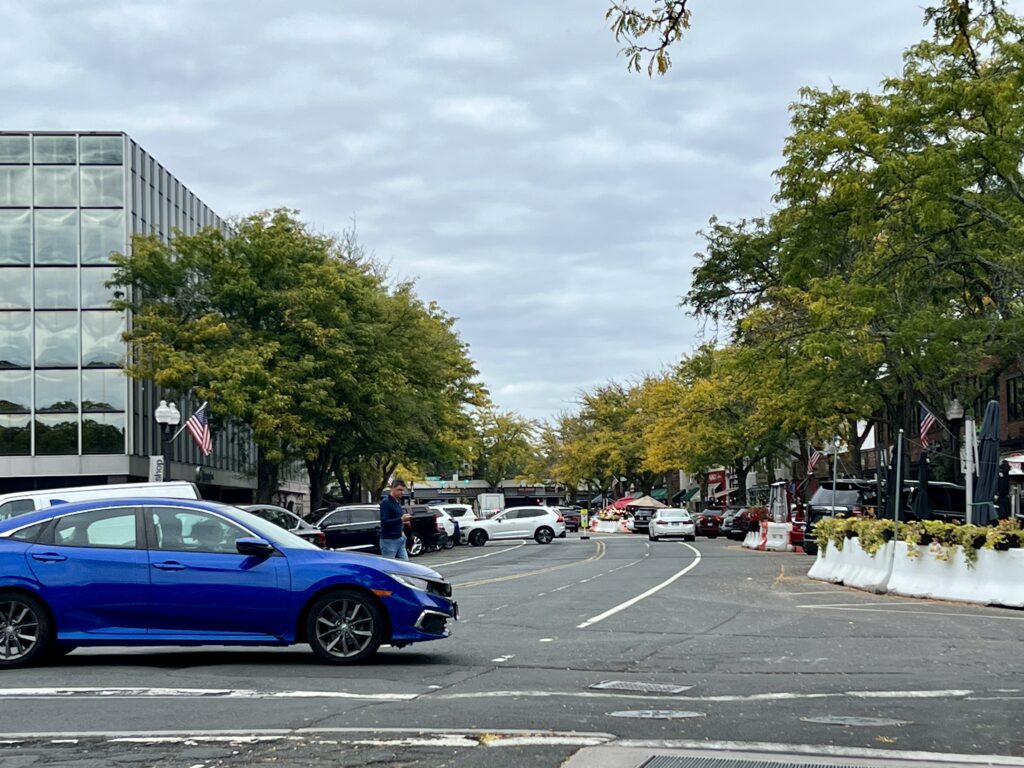
LaSalle Road, Sept. 23, 2024. Photo credit: Ronni Newton
By Ronni Newton
Updates that will be made to LaSalle Road and Farmington Avenue through the West Hartford Infrastructure Master Plan have been finalized, and at Tuesday morning’s meeting of the Town Council’s Community Planning and Economic Development Committee (CPED), Town Manger Rick Ledwith outlined the details of the nearly $10 million project that will move forward immediately and will preserve the Center’s charm while embracing new ideas for the future.
The project – which has been tweaked slightly from the plan outlined in April – will be paid for through American Rescue Plan Act (ARPA) funds, that must be allocated by Dec. 31, 2024, and spent over subsequent two years, so it will be going out to bid and a contractor will be hired before the end of this year.
Included in the chosen plan are wider and more accessible sidewalks, new street trees and lighting, safer crossings, retractable bollards that will facilitate easily closing off LaSalle Road to traffic, and increased access to the Center through the implementation of “mobility hubs.” While bike lanes will not be added on Farmington Avenue at this time, the mobility hubs are, according to the town, “areas people can seamlessly connect to different forms of transportation providing welcoming experiences for our community to connect.”
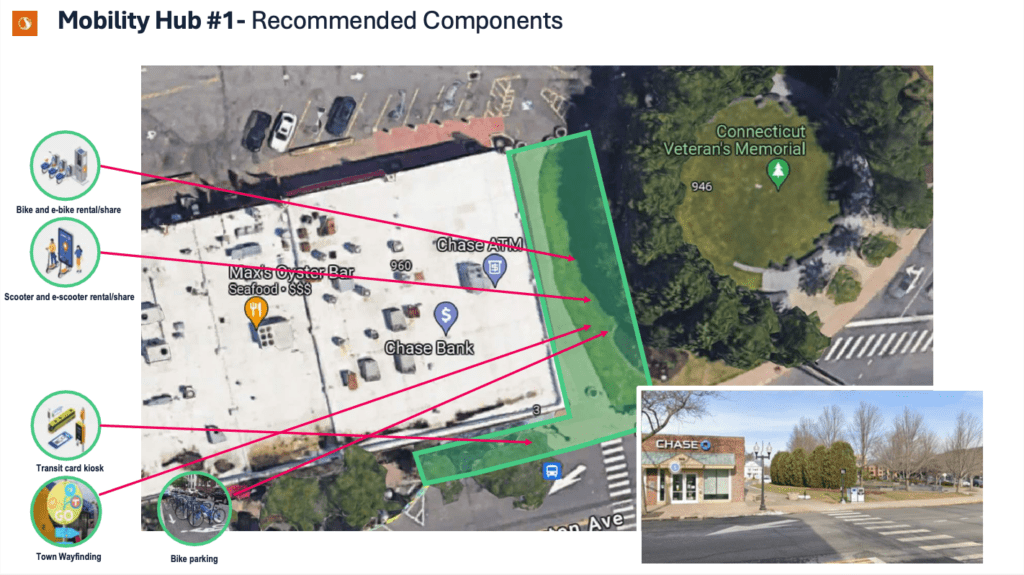
Courtesy of Town of West Hartford
The two hubs will be strategically placed, with one in the current alley between the Veterans Memorial and Chase Bank on Farmington Avenue, and the other in the parking lot at Arapahoe and LaSalle Roads, and the hubs will include bicycle parking, including covered bike shelters, as well as parking and charging for e-bikes and scooters and the possibility of implementing a share/rental e-bike and e-scooter facility in the future. The Farmington Avenue hub, which will incorporate a new sheltered bus stop, will also have a kiosk for purchase of transit cards. The town intends, through the recently-awarded $3.1 million Safe Streets and Roadways for All (SS4A) grant, to also provide a direct connection from the Trout Brook Trail to this hub and to further encourage more sustainable transportation options.
The Arapahoe/LaSalle hub will provide designated spaces for rideshare and food delivery drivers, to avoid double parking and blocking spaces in town. West Hartford Police will enforce the use of the designated areas.
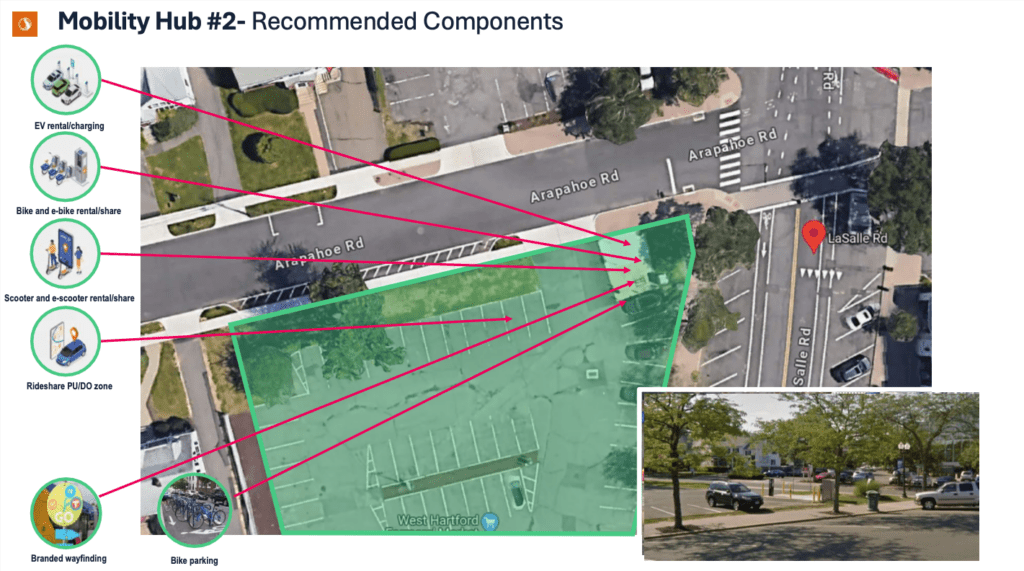
Courtesy of Town of West Hartford
The vision for reimagining the Center began in 2021, when the town received significant ARPA funds that offered a generational opportunity to renovate the Center, Ledwith said at the CPED meeting. Specific development of the West Hartford Center Infrastructure Master Plan has been in the works since 2022. The consulting firm Stantec was hired to assist with the project, which was the outgrowth of a desire to take a holistic approach rather than coming up with piecemeal projects to address long-planned repaving of LaSalle Road and Farmington Avenue in the Center after decades of utility work, as well as the need to address pedestrian safety, accessibility, street trees past their useful life, and other infrastructure updates. The four key elements of the overall plan looked to address the Center’s “sense of place,” sidewalks, transportation, and parking.
Since the initial discussions, there have been extensive engagement through many public and stakeholder meetings as well as surveys with a large amount of input. Through the process, Ledwith said Tuesday, the options were narrowed down to two – one of which was a dramatic change which would significantly widen sidewalks, change all parking to parallel, and add bike lanes on Farmington Avenue, while the other option – the one chosen – would increase sidewalk width somewhat but retain a parking structure similar to the existing situation but with the addition of loading zones.
Both plans had strong supporters, and critics, and discussions continued throughout the summer.
“There was significant concern, especially from our small businesses in the Center” about the more dramatic change, particularly focused on the loss of parking spaces as well as the disruption during construction. While the work will be done in four to six phases, each phase will be four to six weeks under the option chosen, and would be two to three times longer than that for the other option being considered.
“The other challenge we faced with this was funding the project,” said Ledwith. The original allocation of ARPA funds was $3.8 million for updates to both LaSalle Road and Farmington Avenue, and while that was later increased to $5 million, the town has learned over the past several years that construction costs have essentially doubled, he said. The current estimate for this project is $9.9 million – $4.3 million for LaSalle Road and $5.6 million for Farmington Avenue – and if the other option was chosen, that would add $3 to $4 million in costs, said Ledwith.
Multiple projects are currently underway in West Hartford that intersect with the project – including Vision Zero and the updating of the Bicycle Facilities Plan – and town staff have continued to brainstorm on how to best coordinate those projects. “We now have a direct pathway from the west side of town to the east side of town,” Ledwith said of the completed bike lane on Boulevard, and that provides easy access to the Center with bike parking at the Arapahoe hub.
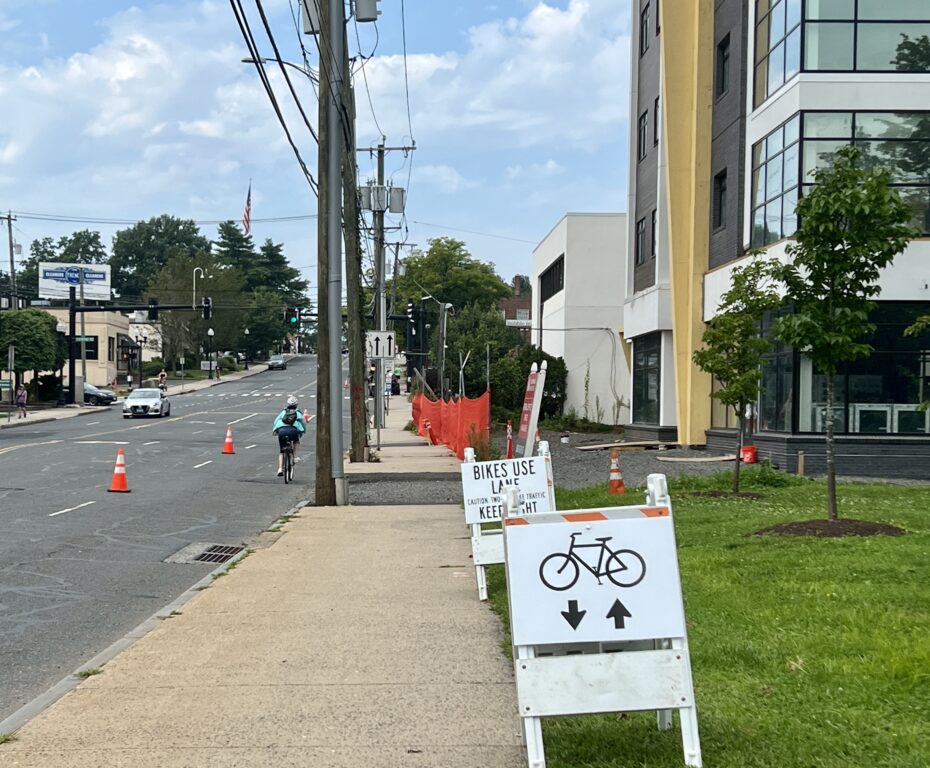
Pop Up bike lane from Trout Brook Trail headed west up Farmington Avenue. Center Streets West Hartford. Aug. 25, 2024. Photo credit: Ronni Newton (we-ha.com file photo)
“Also critical is us receiving the $3.1 million safe streets grant a couple of weeks ago,” Ledwith said Tuesday. The trial of having a dedicated bike lane from the Trout Brook Trail to the Center that was piloted during the Center Streets event in late August was very successful, and according to a camera that was set up there were more than 400 cyclists who used the lane.
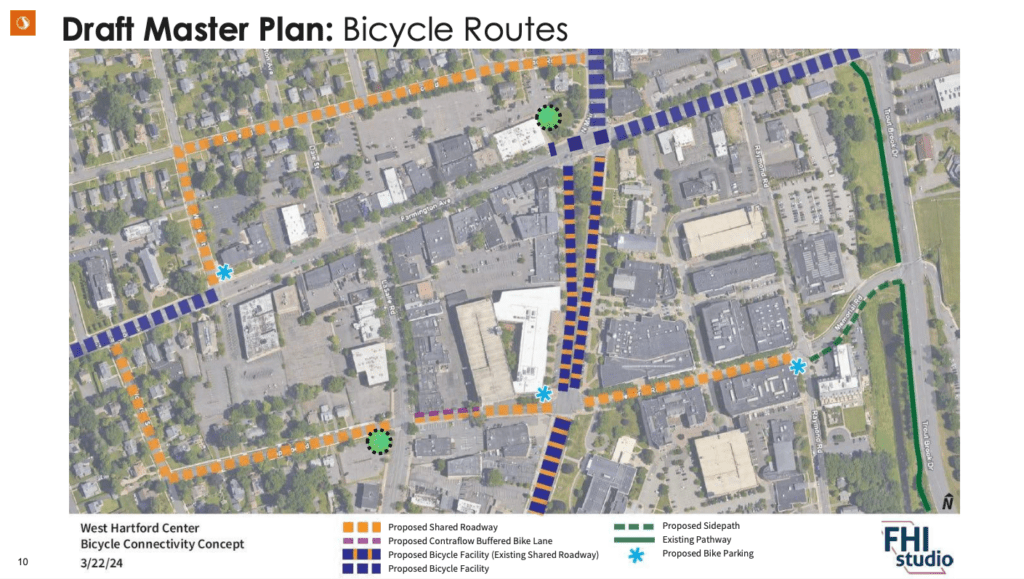
Courtesy of Town of West Hartford
“The concept of mobility hubs was introduced by a member of our staff,” Ledwith said, as a way to connect different forms of transportation. While not the subject of this particular plan, he said it’s a concept that will be considered for both ends of the Trout Brook Trail as well.
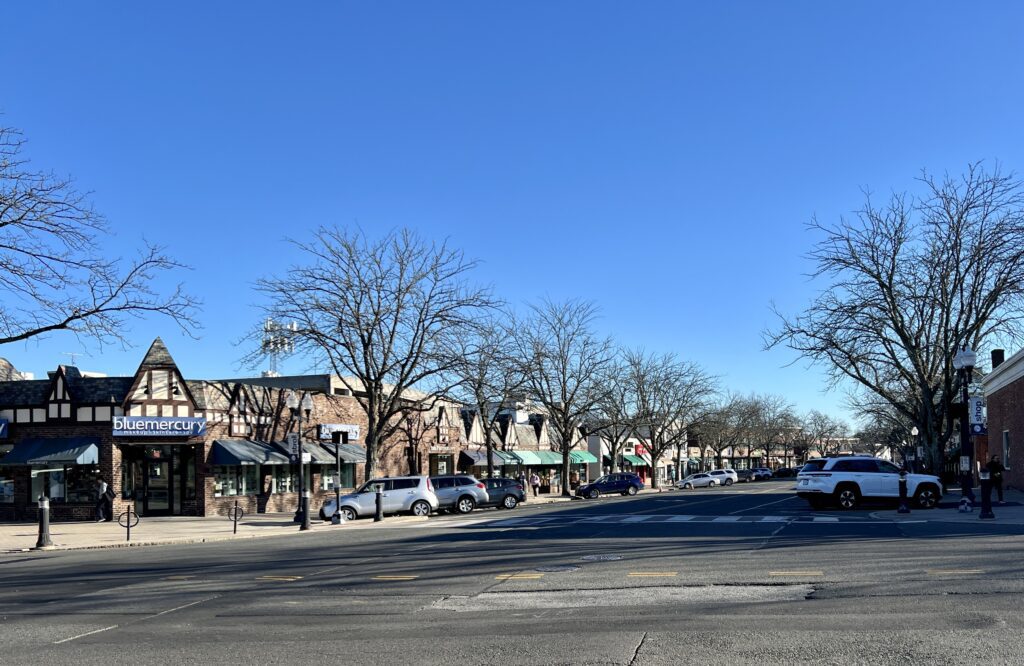
Looking south at LaSalle Road at the intersection with Farmington Avenue in West Hartford Center. Photo credit: Ronni Newton (we-ha.com file photo)
The reimagined “Town Center Infrastructure Master Plan” that will be implemented maintains the current pull-in parking, but builds in safety measures with improved sidewalks and shorter crossings, creates multimodal mobility hubs and flexible spaces, and the retractable bollard system – an idea credited to Mayor Shari Cantor – will allow LaSalle Road to be safely closed for special events or even Sunday mornings in the summer, “all while preserving the neighborhood charm that makes our Center really the best center in the state, all the while keeping the cost of the project within that ARPA appropriation,” Ledwith said.
“We feel very strongly that this plan reflects our commitment to preserving what makes West Hartford special while embracing new ideas for the future that we’re really excited about,” Ledwith said.
“This collaborative, community-driven plan sets the stage for West Hartford’s long-term success,” Cantor said in a statement. “We are committed to creating a safer, more accessible, and interconnected community, all while preserving the unique charm that makes our town a wonderful place to live and work.”
Cantor expressed her gratitude for the diverse group of stakeholders involved in the planning process – advocates for pedestrians, cyclists, and the mobility challenged as well as local businesses.
Following the presentation at the CPED meeting, Deputy Mayor Ben Wenograd referred to debate about parking structure in the Center – parallel vs. pull-in – and bike access as the “elephant in the room.” It’s been a very long time since anything has been done in the Center, and he said while dramatic changes are a lot to consider at one time, this should not be considered as a “forever” plan. “I think we need to be more nimble than that.”
Ledwith said this plan doesn’t permanently tie the town to pull-in parking, and bike lanes could be added in the future, once these updates are made and the plan is allowed to mature.
“The door is not closed,” Cantor said, for future updates to improve the community. “This has been a long time coming,” she said, and while the real focus was pedestrian safety and traffic calming, this plan is not stopped in time, she said at Tuesday’s CPED meeting. “The character of the Center is so important to the success of the Center,” it’s important to avoid sterileness, and even these changes are going to be challenging.
“The West Hartford Chamber of Commerce commends the Town Manager and staff for pursuing an infrastructure improvement plan for West Hartford Center that balances the needs and concerns of residents, customers and business owners,” said Chuck Coursey, vice chair of the West Hartford Chamber of Commerce. “We are especially grateful that they took the time to listen to all points of view and ultimately chose a plan that increases areas for pedestrians, provides greater accessibility and safety for bicyclists and mitigates business disruption for our community’s chamber members and small business owners.”
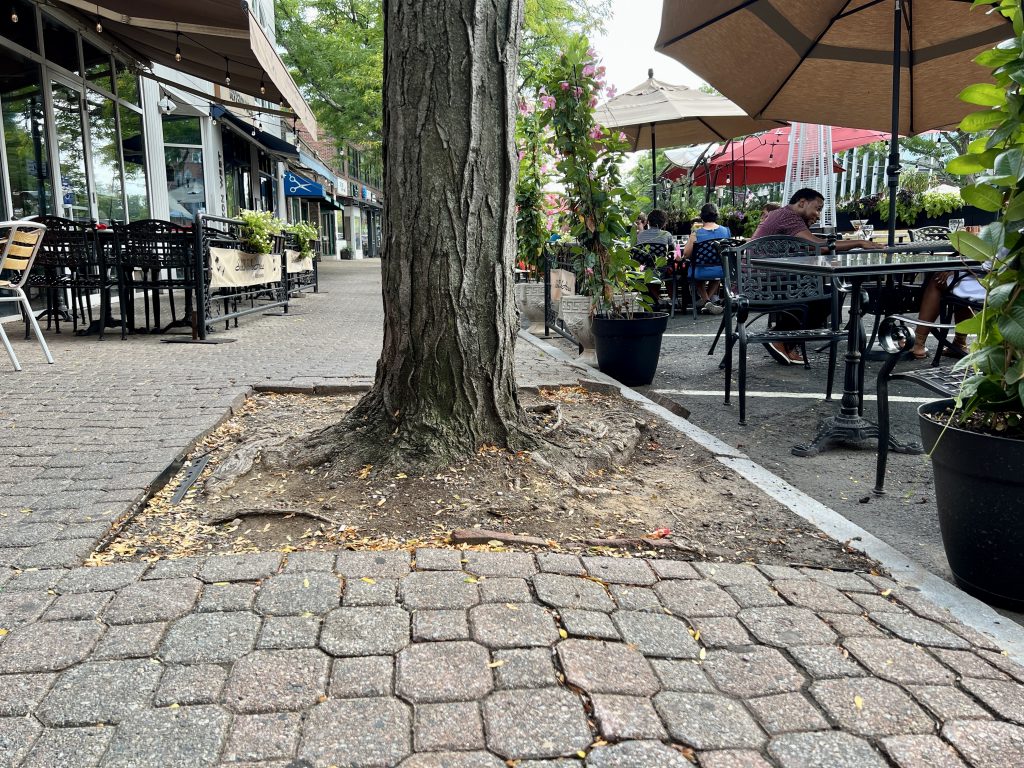
Existing sidewalks in West Hartford Center are extremely narrow in certain areas, and tree roots are protruding and also pushing up sidewalk pavers. Photo credit: Ronni Newton (we-ha.com file photo)
Design specifics
Travis Ewen of Stantec, who is also a landscape architect, outlined more specific details planned for each roadway on Tuesday morning.
“You all know the conditions in the town center,” he said, noting that trees and sidewalks are at the end of their lifespan. Pedestrian safety at crosswalks as well as providing more accessible routes for pedestrians and cyclists were a key part of the plan.
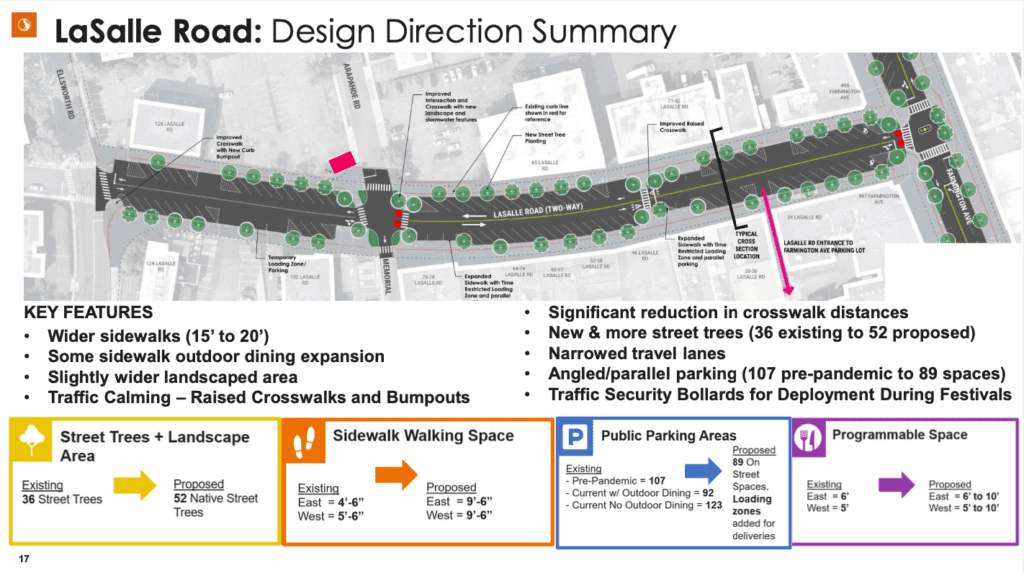
Courtesy of Town of West Hartford
On LaSalle Road, sidewalks will be increased from 15 to 20 feet to allow more outdoor dining space, the number of trees will be increased from 36 to 52 native street trees using “innovative ways of providing ample soil.” There will be traffic calming measures including bump-outs for crosswalks, loading zones and some parallel parking, and overall a change in the number of parking spaces from 107 (pre-pandemic) to 89 on-street spaces.
Ewen also noted the addition of bollards, which may either be removable able to retract into the ground.
On Farmington Avenue, the roadway will actually be reduced from 70 feet to 60 feet curb-to-curb, which allows for wide enough travel lanes “but provides the ability to expand the sidewalk by 5 feet,” he said. There will be raised crosswalks and bump-outs to increase pedestrian safety, and a mix of parallel parking (also to be used as loading zones) and pull-in parking.
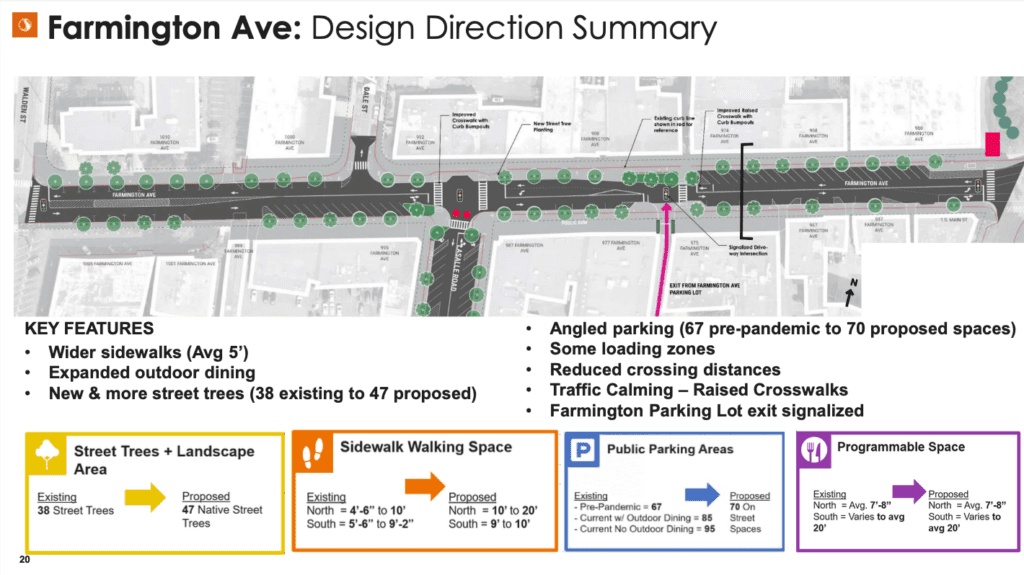
Courtesy of Town of West Hartford
The number of street trees on Farmington Avenue will also increase, from 38 honey locusts to 47 native street trees. On both Farmington and LaSalle, he said, a variety of trees will be used to provide a “diverse canopy.”
On both LaSalle and Farmington, Ewen noted that the Town Center Infrastructure Plan calls for new bench seating, bicycle parking, maintaining the existing type of trash receptacles, and all new pedestrian lighting. Cast in place concrete sidewalks with a pattern will be non-slip and provide ADA compliance.
Phasing “was one of the major concerns we heard from business owners,” Ewen said, and that led to the proposed plan of four to six week blocks. Pedestrian access to businesses will be maintained at all times, he said.
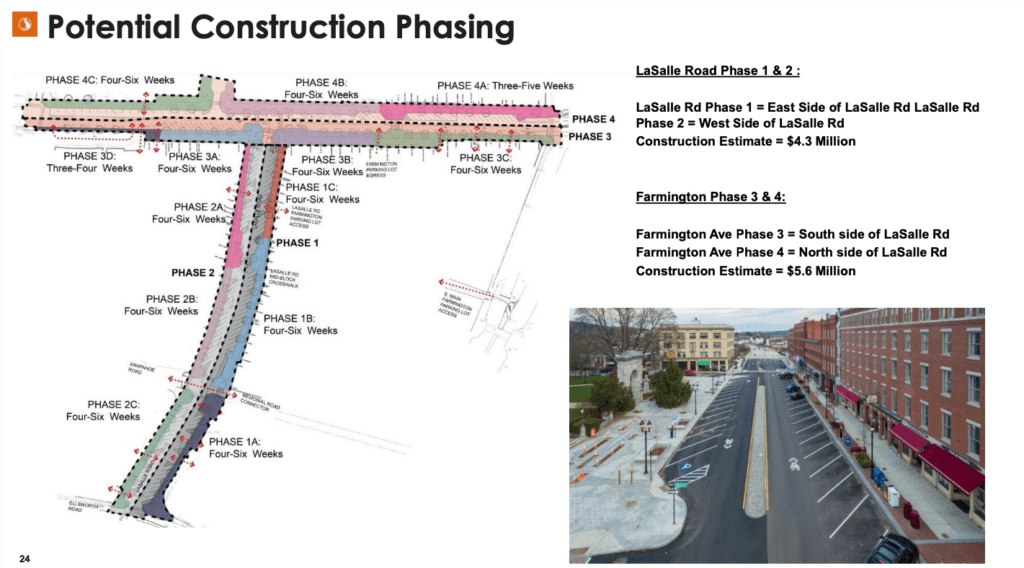
Courtesy of Town of West Hartford
When will the project begin?
The contractor will be chosen by the end of 2024 and according to Ledwith the construction will begin on LaSalle Road in early 2025 and on Farmington Avenue in early 2026. The work will be done in phases and the Center will remain accessible at all times.
“This plan reflects our commitment to both preserving what makes West Hartford special and embracing new ideas for the future,” Ledwith said in a statement. “It’s a balanced, thoughtful approach that takes into consideration the feedback we received from a broad range of voices in our community. We are excited about the ways this plan will improve safety and enhance all that our town has to offer for residents and visitors, while promoting economic growth.”
Future updates and related development
There are multiple development projects also underway or about to break ground in the Center, in particular the Center Park Place condominium project and future 75 LaSalle apartment building that are in the area being affected by the Town Center Infrastructure Master Plan.
Council member Carol Blanks asked Tuesday about the impact of those projects, and Ledwith said town staff is in contact with the developers nearly ever week, and they are aware of the schedule and the work will be coordinated.
Wenograd asked what is being done about other difficult intersections – such as North Main Street and South Main Street with Farmington Avenue. Ledwith said those discussions have been taking place and will continue into the future, and are also related to the Vision Zero project. While there has been talk about a roundabout, peanut-about, and even working with First Church to relocate Unity Green, “that will require additional funding,” Ledwith said.
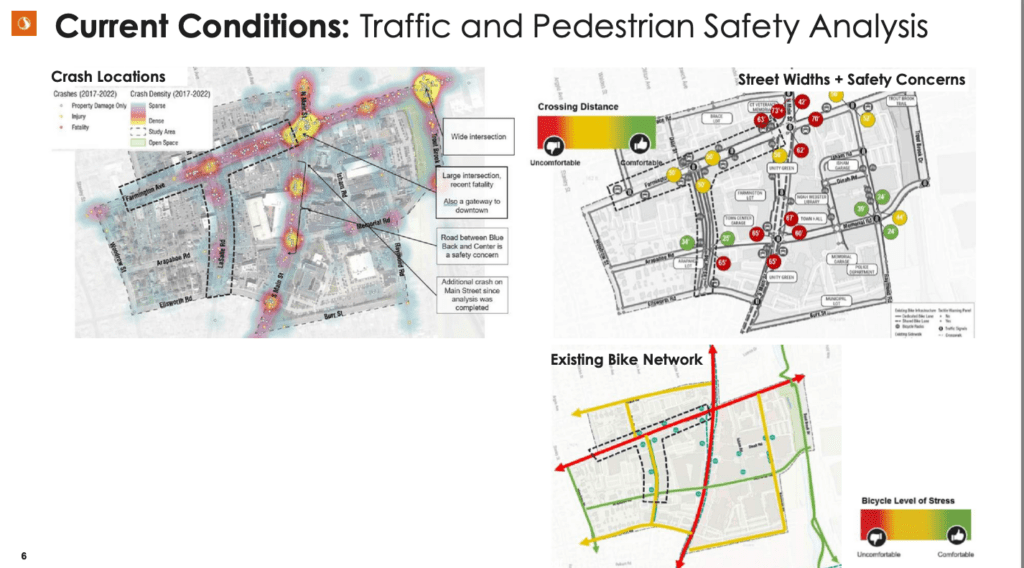
Courtesy of Town of West Hartford
Like what you see here? Click here to subscribe to We-Ha’s newsletter so you’ll always be in the know about what’s happening in West Hartford! Click the blue button below to become a supporter of We-Ha.com and our efforts to continue producing quality journalism.




I’m very disappointed in our town’s inability to create safe biking options for families with this plan. The town decided businesses were more important than families and safety. This was an opportunity for our town to build for the future rather than to stay in the past.
There’s a patchwork logic to this (putting in mobility hubs for e-bikes and e-scooters) when there are no actual plans for and no existing bike lanes. I would feel more confident in this if someone from the Pedestrian & Bicycle Commission were involved in the actual brainstorming and discussion between April and now. It sounds like Option A ultimately was too costly – who decided what could be saved and what had to go? Were cheaper alternatives explored, and how did decision-makers land on what was essential to this plan? Disagreement is fine and not everyone is going to get what they want – I just want to be able to trust members of the community were actually involved in this important process and could speak about the logic behind the final plan.